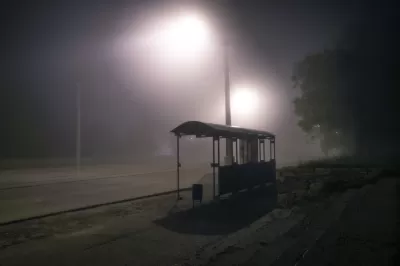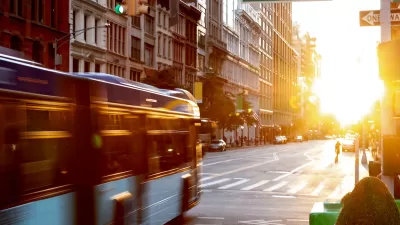Operator shortages are causing transit agencies to cut service unpredictably, leaving riders waiting for ‘ghost buses.’

A blog post from Transit Center explains the phenomenon of “ghost buses,” buses that appear on smartphone apps as minutes away only to never materialize at the station.
“What’s behind this alarming rise in ghost buses? Amid a national shortfall of transit operators, years in the making and worsened by the pandemic, there simply aren’t enough bus operators to run all the trips that transit agencies schedule.” In Los Angeles, the county’s transit agency canceled 1 in 6 trips in January of this year due to a shortage of 600 operators.
There are technical challenges to tracking ghost buses, for riders and agencies alike. Transponders aboard en-route buses share their locations via GPS, feeding real-time arrival boards and trip-planning apps. Canceled trips don’t generate GPS locations, so apps reference and display scheduled arrival data instead. This misleads riders into thinking their bus is running when it’s not.
The blog post recommends that transit agencies begin by tracking and publishing canceled buses to provide more transparency and identify solutions. “Agencies also need to be realistic about the amount of service they can provide with the labor force they have, and adjust schedules accordingly.”
The root of the problem, the blog post cautions, is the structural problems leading to the operator shortage. Transit agencies “must radically improve the job for operators by raising pay and improving working conditions. They must also attract new operators by offering signing bonuses and addressing roadblocks to starting the job, like long waits to receive commercial drivers’ licenses and unnecessarily strict drug testing.”
FULL STORY: Ghost Buses are Haunting Riders Across America

Planetizen Federal Action Tracker
A weekly monitor of how Trump’s orders and actions are impacting planners and planning in America.

San Francisco's School District Spent $105M To Build Affordable Housing for Teachers — And That's Just the Beginning
SFUSD joins a growing list of school districts using their land holdings to address housing affordability challenges faced by their own employees.

The Tiny, Adorable $7,000 Car Turning Japan Onto EVs
The single seat Mibot charges from a regular plug as quickly as an iPad, and is about half the price of an average EV.

Seattle's Plan for Adopting Driverless Cars
Equity, safety, accessibility and affordability are front of mind as the city prepares for robotaxis and other autonomous vehicles.

As Trump Phases Out FEMA, Is It Time to Flee the Floodplains?
With less federal funding available for disaster relief efforts, the need to relocate at-risk communities is more urgent than ever.

With Protected Lanes, 460% More People Commute by Bike
For those needing more ammo, more data proving what we already knew is here.
Urban Design for Planners 1: Software Tools
This six-course series explores essential urban design concepts using open source software and equips planners with the tools they need to participate fully in the urban design process.
Planning for Universal Design
Learn the tools for implementing Universal Design in planning regulations.
Smith Gee Studio
City of Charlotte
City of Camden Redevelopment Agency
City of Astoria
Transportation Research & Education Center (TREC) at Portland State University
US High Speed Rail Association
City of Camden Redevelopment Agency
Municipality of Princeton (NJ)





























